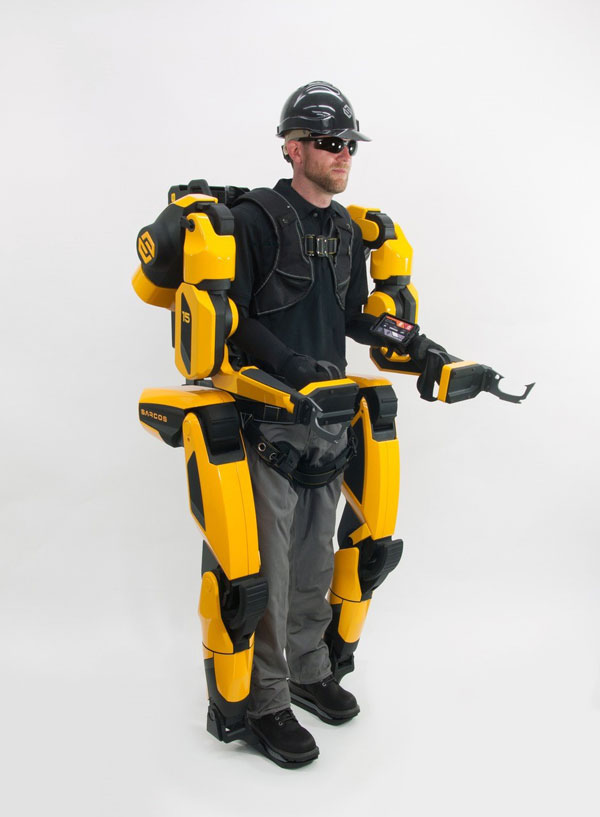An American robotics company has developed an all-electric, battery powered, full-body industrial exoskeleton robotic system that aims to improve safety, productivity and efficiency for workers in the construction industry.
The Guardian XO Max exoskeleton robot, developed by Sarcos Robotics, will enable the human operator to safely lift and support up to 200 pounds without fatigue or strain for up to an eight-hour work session, said Kristi Martindale, executive vice-president and chief marketing officer of Sarcos Robotics, which is based in Salt Lake City, Utah.
“It takes what the humans are best at, which is intelligence, instinct and judgement and combines it with what robots are best at which is strength and endurance,” she said.
The company designs, develops and deploys energetically autonomous robots.
The manufacturing and construction industries, in particular, are facing an unprecedented shortfall of labour and increasing occupational injuries, Martindale pointed out.
“We saw this opportunity to do something different and really augment the human workforce in a way that helps them be more effective, gives them a longer work life and a more productive and healthy work life, while also helping the employer by enabling them to satisfy some of this gap in the worker shortage,” she said.
As an example, Martindale cited a potential customer who has a large drywall operation but cannot find enough workers. The employer said it takes about three years for workers to become highly proficient at the job.

“By that time the wear and tear on your body tends to make people move out of that role because lifting that weight…on a regular basis, there are only so many hours in a day a human can do that and there is only so many years they can do that type of work before it takes a toll on their body,” said Martindale, noting some drywall pieces can weigh up to 200 pounds.
“In the construction industry specifically, and if you think where drywall is installed, it’s not something that can be easily automated. There is some finesse and dexterity required to do that in a very proficient and effective way.”
The technology is targeted to a number of sectors including construction, manufacturing, automotive, aviation and aerospace, oil and gas and utilities, or any industry where automating the environment would be too costly, ineffective or not practical.
“There are a lot of systems that people use now that can do some of these jobs in construction,” said Martindale. “What we found is that there are limitations with some of the traditional equipment in terms of either it needs to have a fixed path or the workplace has to be mapped and designed for the tool rather than really being able to have the tool work in the confines of the workspace.”
The suit requires less than 400 watts of power and works up to eight hours on a single charge. Its battery can be swapped in and out in the field without losing power and workers are able to get in or out of the suit in less than a minute, Martindale stated.
The entire weight of the suit is transferred through the suit’s structure to the ground, which results in the offloading of 100 per cent of the weight the worker is bearing as well as the weight of the suit itself, which weighs about 175 to 180 pounds, Martindale explained.
The system took 17 years to develop and more than $175 million was invested in research and development.
“Overcoming power utilization and powering the suit in an autonomous fashion was a fairly significant challenge,” she explained, adding previous iterations were powered by hydraulics or tethered. “The misperception in the market is that this wasn’t viable to create a full-body, full powered suit that can operate in a meaningful way for an extended period of time, doing meaningful work, autonomously powered.
“Those three things: the human-like dexterity, the intuitive operation and control and the battery…we felt like those were the keys to being a very effective and viable commercial product.”
To simplify the operation, use and minimize the need for training, Sarcos implemented the “Get-Out-of-the-Way” control system.
“It needed to be intuitive, so there are a lot of sensors and design elements in the exoskeleton suit that allow it to be operated as if you are just doing your natural human movements,” said Martindale. “The way the suit operates is when your arm moves, the suit senses that movement and gets out of the way, so it basically follows the path of your arm as you are moving. It makes it really feel more like an extension of you as a person. It’s not a person modelling their movements to the machine, it’s the machine modelling its movement after the human.”
The company is planning to release the product commercially in late 2019. They are currently taking orders and expect to begin shipping to customers in early 2020. In terms of the business model, the intent is to deploy the Guardian XO and Guardian XO Max as part of the staff.
“The idea is ‘Robotics-as-a-Service model,’ so it would be on your payroll. The cost would be the equivalent of a fully burdened $25 an hour employee,” said Martindale. “We expect that the suit will be leased for a three-year period.
“We estimate that it’s going to be in the range of $100 to $150,000 a year.”







Recent Comments
comments for this post are closed